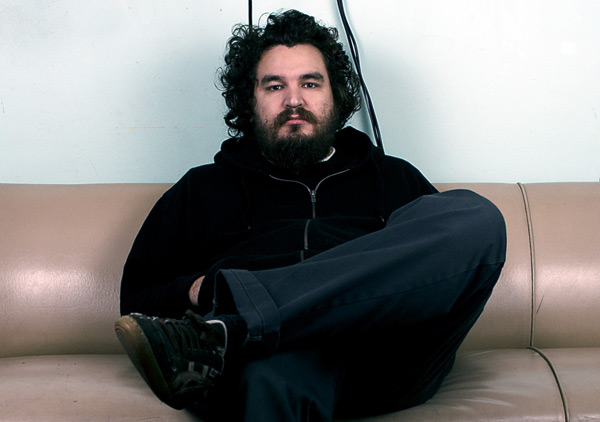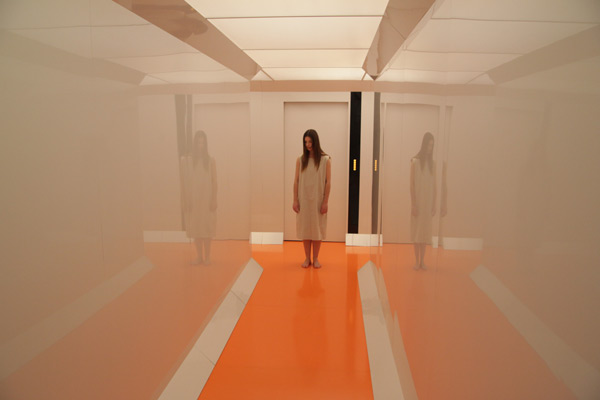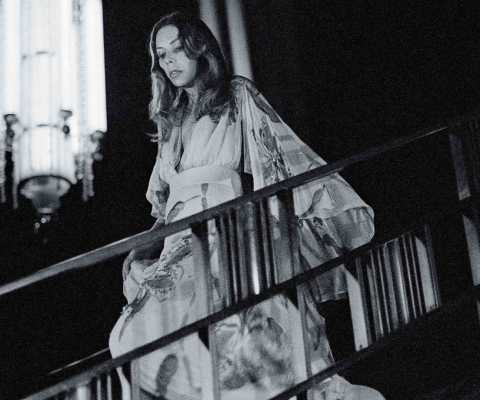While it might not be accumulating nearly the same volume of online chatter, believe it or not there is actually another callback to 70s science fiction hitting screens this week. This film isn’t a $120 million 3D blockbuster with ties to an old franchise. Nope, Beyond The Black Rainbow is a deeply bizarre science fiction/horror film set in an alternate 1983 in a style of how that future was pictured in the 70s. It’s about a mysterious mind control experiment crushing a trapped young girl and driving a scientist insane. Of course, descriptions of the plot don’t really offer much explanation for the film, which is more about mood, tone, sound, and ideas than anything else.
First time director Panos Cosmatos (son of George P. Cosmatos, who directed Tombstone, Cobra, and Rambo: First Blood Part II) recreates the aesthetic of late 1970s sci-fi with such mind-boggling attention to detail that it would be easy for an unsuspecting viewer to assume they stumbled onto a lost film from that era. Shot on grainy film stock, designed with retro-future costumes, scored by analogue synthesizers, and featuring lovingly crafted practical effects, it’s an incredible stylistic accomplishment and one hell of a head trip. Beyond The Black Rainbow might not be getting the same push as that other retro sci-fi movie coming out this week, but for true fans of that genre and era of filmmaking, it might actually be the best choice. We got a chance to chat with Panos Cosmatos about the conception and production of his remarkable debut, as well as growing up in a house with the guy who made Rambo.
Dork Shelf: Where did the film begin for you? Did it start with the desire to recreate these lost 70s sci-fi movies or with something else?
Panos Cosmatos: I started with the story. I’ve been working on the script in various forms for a very long time. It started as this idea about a girl in an asylum and the doctor early on. I guess, back about six years before I wrote it. I just never finished writing it, but after my dad died I started revisiting all these old films from my childhood and the aesthetic of that started to overlay onto that story. Then I had this other concept that I wanted to do as an art piece. In the town that I lived, I wanted to find an empty store front and install a crappy little display for an institute that doesn’t exist and have people pamphlet it. And then one day it just sort of clicked for me that was part of this idea too. All these different elements that I had in my mind started to merge together and that became the film
DS: What were the movies that you had in mind as the template for the style of Beyond The Black Rainbow and what about them struck that chord?
PC: It wasn’t really any specific film. One of the things that I really remember from my childhood was being in a store called Video Addict and not being able to watch the horror films, so I would look at the covers and read the back of the box to imagine my own version of the movie. That was the other element. I wanted to create a film that is a sort of imagining of an old film that doesn’t exist. It started as that sort of abstract concept, if that makes sense.
DS: When you were finally able to see those old movies, did they ever live up to what you had imagined?
PC: Sometimes yes, sometimes no. I think sometimes a film can’t even be seen for what it really is during the era that it’s made. So, a lot of these films have become an interesting works of art just by aging.
DS: What made you set the film in 1983? Is there something significant about that year?
PC: Well, that was the year that I started going to Video Addict. But also, in the storyline itself, I thought the year makes sense for the ages of the characters and the timeline from 1976 onwards. I also thought it was kind of funny to set it in the year right before 1984, which is the iconic science fiction year. It was little opportunity in that way to acknowledge that it’s not as important as 1984.
DS: How did you approach writing a film like this since it’s a project defined more by images, mood, and tone than dialogue or even narrative?
PC: It’s hard to say in retrospect. I just started piecing together ideas that came to me and scenes that I wanted to see. Eventually it started to take on a life of its own and the characters took on a life of their own. I wouldn’t write it in order, but sometimes I would write a scene that would take place much later and that would spark ideas of how to pull it together.
DS: How difficult was it to find financing for a project as experimental and out there as this? I’d imagine there would have been a lot of scratched heads while you were pitching it around.
PC: Well, I self financed it, but that didn’t stop people from scratching their heads when I was trying to talk them into working on it (laughs). The people that responded to it responded to it very strongly and wanted to be involved. It was just hard to find those people at times. The only reference they had for my work was a music video that was online. So that would show them that perhaps that mentality combined the script could be something interesting.
DS: What led you to shoot in Vancouver?
PC: Well, I live on Vancouver Island and wanted to shoot it there, but decided that logistically that was pretty much impossible because there’s no filmmaking infrastructure there. Generally any movie that shoots there brings their own infrastructure. So I just decided, “fuck it” and I moved to Vancouver, which sped up the process a lot.
DS: How did you manage to replicate that vintage look? Did you actually track down old equipment to use or was it all replicated digitally?
PC: We shot on 2/3 35mm, so it’s like a half a 35mm frame for each frame. We shot it on an old Panavision from the 80s, I believe. It was a giant old heavy camera. The cinematographer and I talked a lot about how important I thought it was that the grain be as natural as possible. So he used a lot of exposure techniques to lift the grain more.
DS: How about the special effects? It didn’t seem to me that there was any CGI, but I’m not sure if maybe you were just using it subtly.
PC: There were a couple of shots that were created digitally and one those was actually blended with an analogue shot. For example, I think it was the winter of 2008 I shot a lot of the cloud tank elements. Basically every special effect in the movie is practical except for a few. I just love the way that kind of stuff looks and because the whole movie is supposed to be an imagined artifact from the past, the only way I could create that feeling properly was to use the old techniques as much as possible.
DS: How involved were you with the score because it felt so integral to the mood and tone? I’d imagine it was something you wanted to be heavily involved in.
PC: Well, Jeremy Schmidt from Black Mountain wrote the score and has an amazing record collection of soundtracks and synth music from the 70s and 80s. He’s very influenced by that time and writes this amazing music that he records on analogue synthesizers. Once I discovered him, I really wanted him to score it. I showed him a rough cut and he really wanted to do it. I think he drew influences from a lot of not just soundtracks, but different artists from that era. John Carpenter was definitely part of that, but there were so many. I don’t know, our musical sensibilities were so close that I gave him some guidance, but generally I just let him create and it was like Christmas. Because I’m a fan of his, it was amazing to just to get to hear him create music and put it on my movie.
DS: I noticed that the sound design by Eric Paul was listed very early in credits, which struck me as being a sign that he was very important to the film. How closely did you two work together?
PC: Yeah, I mean I feel like the sound design is an incredibly important element of the film. Especially for the atmosphere, but also some story elements are indicated by abstract sound. So, he’s a musician as well and designed the sound design at certain points to merge perfectly with the score, right down to counting out the beats per minute and the tuning of it so that it would merge with the score. THX 1138 has always been a key influence in my mind going all the way back to my first Super 8 short, so I’m sure that was part of it.
DS: How do you think growing up the son of a director shaped you as a potential filmmaker? Was this something you always knew you wanted to do?
PC: Well, I didn’t know it was what I wanted to actually. I was always exposed to movies from the day I was born in various ways. When I was little we lived in Sweden and back then we had these Super 8 highlight reels of movies from the 70s that were sort of the best parts of movies from that era sold on a highlight reel. Things like Now You See Me Now You Don’t, Star Wars, 1 Millions Years BC, The Three Caballeros, one of the Herbie movies. There was a few of them. And then a few years later my father started taping movies off of HBO, Cinemax, and The Z Channel. So he had a pretty enormous collection of movies from every era on Beta and I started to dip into that over the years. That’s sort of how I learned about cinema history, going through those hundreds and hundreds of tapes. My mother was also a huge influence. She was an experimental artist with a hugely open attitude towards creativity. She was always very supportive of my creativity. So, I think I have developed my sensibility between those two sources. My father was very traditional in his thoughts of what movies should be and my mother had a more experimental attitude that taught me to go a lot farther with things.
DS: Do you know what you’ll do next? Something with a more contemporary setting or do you want to stick to that “lost movie” style?
PC: I don’t want to be redundant and make everything I want to do a stylistic experiment unto itself. That would get boring. I do love the aesthetics of old movies, so I think that will continue to be an important part of what I do, at least for now. The thing I’m writing right now is kind of the flipside of the coin to Black Rainbow. Because that movie is all about repression and control and those themes do interest me. Whereas the new thing is sort of about the venting of emotion, a primal expression, and confession.
DS: Any chance I can get you to say what it’s about?
PC: Yeah, I can’t talk about it (laughs).








Comments